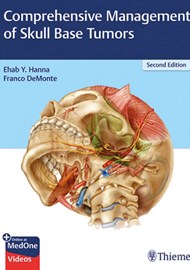This is the second edition of a multi-author textbook first published over a decade ago. Most of the chapter authors are North American, as are the editors themselves. There is also a smattering of well-known contributors from the rest of the world. A single volume of approximately 630 pages, it is very well illustrated throughout with colour diagrams and photographs. In addition, it is well indexed, making searching specific topics very straightforward.
The book itself is divided into three distinct sections. The first section, ‘General Principles’, covers areas one would expect e.g. basic science, imaging, principles of assessment and nonsurgical treatment options. However, there are also excellent additional chapters on SALT rehabilitation, cerebrovascular management, and neuropsychological assessment; topics often omitted or merely glossed over in other texts. Chapter six provides an excellent summary of endoscopic skull base surgery, its multidisciplinary nature, explanations of surgical planning modules (coronal and sagittal) and general training principles.
The remaining two sections address skull base surgery from two different perspectives: the second section in relation to anatomical perspectives and the third section to tumour histology. This works well for both specific queries and the casual reader, who may have a limited understanding of skull base surgery, to expand their knowledge from an anatomical or pathological perspective. The format of the second section follows a broad template of anatomical principles, differential diagnoses, assessments, and surgical approaches. The options of endoscopic or open approach are discussed, including pros and cons of both, with the final section on outcomes and prognosis. Chapter 16, surgical management of tumours of the nasal cavity, paranasal sinuses orbit and skull base, is particularly good with useful discussion on the management of the orbit and contraindications to endoscopic approaches. Chapters 18 and 19, on clival and infratemporal fossa tumours respectively, are both excellent. In contrast, disappointingly, chapter 17 has very limited discussion about endoscopic nasopharyngectomy and chapter 20 fails to mention the option of robotic transoral surgery for parapharyngeal space lesions. Further chapters address lateral skull base surgical approaches including the petrous apex, cerebello-pontine angle, jugular foramen and cranio-vertebral junction. Chapter 28 addresses tumours of the orbit and, although rather brief, has details of both endoscopic and traditional approaches to both intra and extraconal pathology.
The third and final section provides detailed knowledge of the various tumour pathology types, how they interact and are treated in specific sites. The first two chapters in this section on squamous cell carcinoma and non-squamous cell carcinoma are both excellent, with useful tips from leaders in the field of skull base surgery. Further excellent chapters include those on melanoma and sarcoma, often missing from similar texts. Chapter 31 on olfactory neuroblastoma is rather short and lacks operative detail. Chapter 39 on pituitary adenomas is of fundamental importance as this is by far the most common pathology found in the anterior skull base. It is very well written, clear and up to date. Chapter 37 on schwannomas of the skull base nicely covers the lower cranial nerves although there is only limited information on vestibular schwannomas themselves.
The authors acknowledge that some redundancy is inevitable because of the organisation of the textbook. However, I did not consider there was unnecessary overlap and would agree that a diversity of opinion is to be expected in skull base practice.
The accompanying e-textbook was accessed on mobile phone. No difficulties uploading and gaining access to this version were noted and topic searching was straightforward. No doubt it will prove very useful to access all this information on the move! There are a limited number of accompanying videos online, although these do not cover the multitude of surgical procedures described in the textbook.
Overall, this is an excellent book and is good value for money at £191.50. I particularly welcomed the balance of opinion regarding the pros and cons of both endoscopic and open approaches in most of the chapters. Too often, similar texts fail to achieve this balance and tend to reflect a strong bias to one approach even in the absence of good underlying evidence. Bearing this in mind, I consider the book a ‘must’ purchase for any department undertaking management of skull base tumours and commend it as an individual purchase for experienced surgeons and trainees alike who have a particular interest in this subject.





